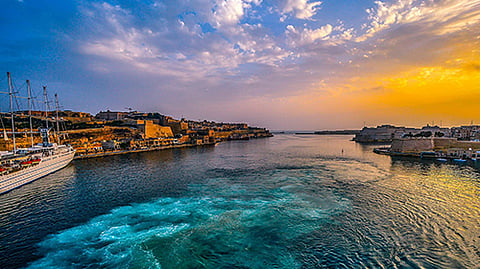IMO MEPC Approves Mediterranean Sea Emission Control Area
IMO's Marine Environment Protection Committee has reiterated its commitment to review and strengthen the IMO Initial Strategy on the reduction of GHG emissions from shipping, with a view to adopting a revised strategy in mid-2023.
The MEPC 78 session (6-10 June) made further progress with the discussions towards the revision of the Initial GHG Strategy, as initiated during the last session (MEPC 77).
The revision will take into account the commitment to strengthen the levels of ambition of the Initial Strategy and the needs of developing States, in particular small island developing States (SIDS) and least developed countries (LDCs).
Further work will continue in an intersessional GHG working group (ISWG-GHG 13) before the next session (MEPC 79, 12-16 December 2022) and further sessions of the working group.
Developing a basket of mid-term GHG reduction measures
The MEPC noted the progress made by the Intersessional Working Group on Reduction of GHG Emissions from Ships (ISWG-GHG 12) in advancing towards the further development of a "basket of candidate mid-term measures" – integrating various technical elements.
The MEPC noted the need for additional information on the proposed mid-term measures.
It encouraged proponents of measures to work together intersessionally with a view to exploring how different elements of these proposals could be combined in the context of a basket of mid-term GHG reduction measures.
Member States and international organizations were invited to submit new documents to a future session of ISWG-GHG, including refined proposals to that purpose.
The intersessional working group (ISWG-GHG 13) will further consider the proposed measures.
Guidelines adopted to support short-term measure
The MEPC adopted a series of guidelines to support the implementation of the short-term measure to reduce ships' carbon intensity in accordance with the timelines set out in the Initial IMO GHG Strategy.
The short-term measure enters into force on 1 November 2022 and introduces the Energy Efficiency Existing Ship Index (EEXI); the annual operational carbon intensity indicator (CII) rating and an enhanced Ship Energy Efficiency Management Plan (SEEMP).
The guidelines include those relating to method of calculation of the EEXI, the revised SEEMP and possible correction factors for CII.
The MEPC also approved draft amendments to appendix IX of MARPOL Annex VI on the reporting of EEXI and CII values to the IMO Data Collection System (DCS). The Committee further agreed to include a new workstream on further revision of the IMO DCS in the agenda of ISWG-GHG 13.
Meanwhile, the intersessional working group (ISWG-GHG 13) is also instructed to complete the lessons-learned exercise of the comprehensive impact assessment of the short-term measure, and in particular finalize the review of the Procedure for assessing impacts.
Development of life-cycle guidelines
The MEPC noted the discussion in the ISWG -GHG 11 on the progress made in the development of draft guidelines on lifecycle GHG/carbon intensity for marine fuels (LCA guidelines) and established a correspondence group on marine fuel lifecycle GHG analysis to further the work.
The correspondence group will submit an interim report to MEPC 79, and final draft guidelines to be adopted by MEPC 80.
The LCA guidelines will allow for a Well-to-Wake calculation, including Well-to-Tank and Tank-to-Wake emission factors, of total GHG emissions related to the production and use of alternative marine fuels.
Mediterranean Sea Emission Control Area for Sulphur Oxides approved
The MEPC agreed to designate the entire Mediterranean Sea as an emission control area, meaning that ships will - from 2025 - have to comply with more stringent controls on sulphur oxide emissions.
In a SOx-ECA, the limit for sulphur in fuel oil used on board ships is 0.10% mass by mass (m/m), while outside these areas the limit is 0.50% m/m.
The MEPC approved proposed amendments to MARPOL Annex VI, with a view to adoption at MEPC 79, which will designate the Mediterranean Sea, as a whole, as an Emission Control Area for Sulphur Oxides (SOx-ECA) and particulate matter.
The amendment could enter into force in mid-2024, with the new limit taking effect from 2025.
There are currently four designated SOx-ECAs worldwide: the Baltic Sea area; the North Sea area; the North American area (covering designated coastal areas off the United States and Canada); and the United States Caribbean Sea area (around Puerto Rico and Virgin Islands).


